Kawai ES120 Piano Review
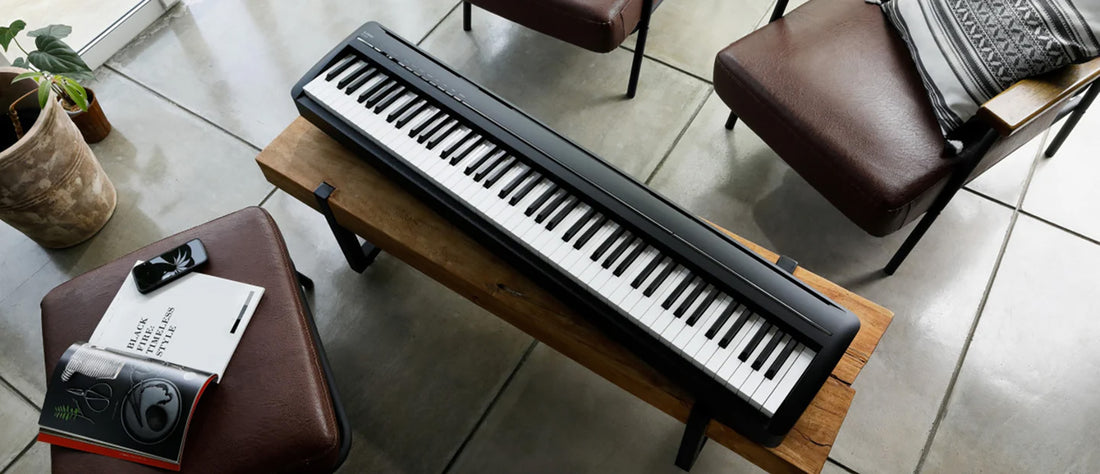
Introduction
Welcome to Bonners' UK buyer's guide and feature review of the new Kawai ES120 digital piano. We've also made a video to complement this article which demonstrates the sounds and also gives additional explanations about some of the ES120's capabilities.
We have tried to make this product review helpful to people who are looking to purchase a new instrument, and hopefully, it will give you all the information you need to make the right buying choices.
Kawai ES120 Piano Review

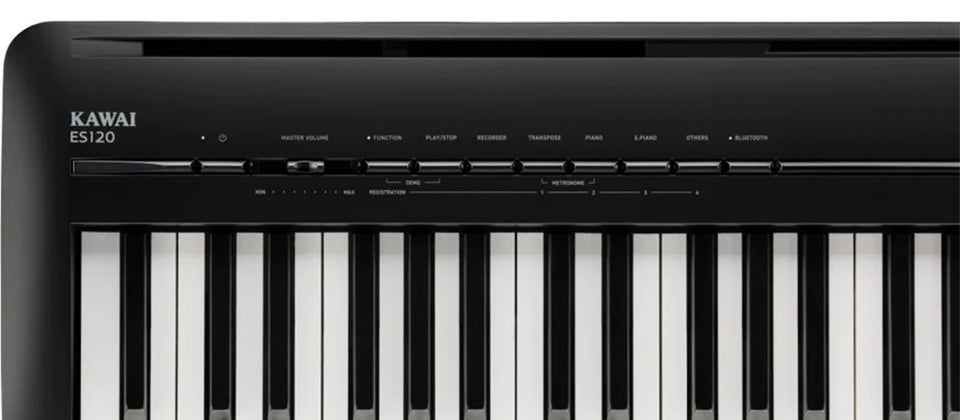
Kawai ES120 Overview
Weighing in at just 12.5kg, the Kawai ES120 is a high-specification, low-price portable digital piano. The ES120 introduces features previously not seen at this price point, including Shigeru Kawai SK-EX Concert Grand piano voice, Bluetooth MIDI + Audio connectivity, GFP3 triple pedal compatibility, ¼" Jack outputs, and registration memories.
The ES120 is the lowest price instrument in Kawai's portable piano lineup, and it joins the popular ES520 and ES920 models. The two higher-priced models offer even more sounds and extra amplification power, but they are also heavier and, of course, higher prices too.
We have also made some demonstration videos of both the Kawai ES520 and Kawai ES920 models, which are worth watching so you can get an idea of the extra features that you get if you're willing to pay the extra money.
Kawai ES120 Piano Review

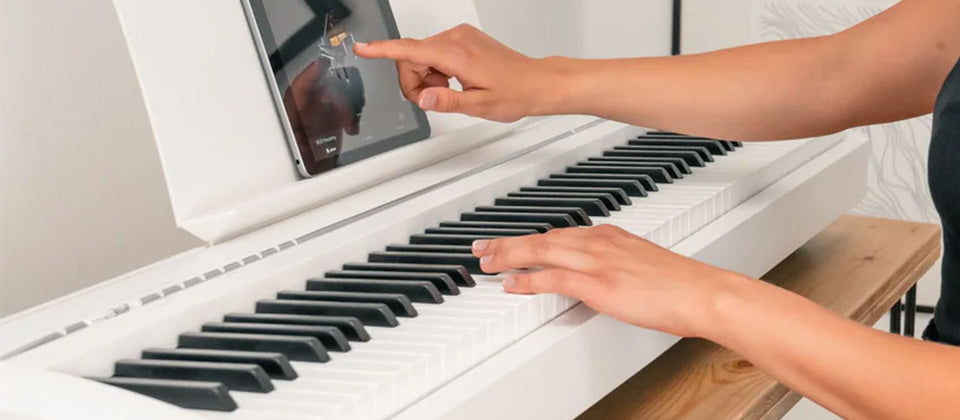
A closer look at what the ES120 has to offer
This new model replaces the extremely popular ES110 piano, of which Kawai sold thousands of units across the World over the last four or so years.
Kawai pianos have always been popular for their warm piano tone and superb keyboard action, and having spent quite a few hours playing the ES120; we can confirm that they have continued this tradition whilst adding a new piano voice and larger speaker system too!
Available in both premium black and white finishes, Kawai has also made available a new stylish wooden keyboard stand to make the ES120 look great in the home, as well as being the ideal portable instrument for on-stage or rehearsal use.
We've put together some Kawai ES120 bundles that include the most popular accessories, such as stands, pedals, headphones, and carry cases.
Kawai ES120 Piano Review

When you first power on the Kawai ES120, the sound you hear is that of the beautiful Shigeru Kawai SK-EX Concert piano voice. We can't believe how good this piano sounds for such a small instrument.
There are a total of eight acoustic piano voices in the ES120, and each one is suited to playing different styles of music. This next voice is the sound of another Kawai Concert Grand piano known as the EX Concert Grand. This one is slightly brighter in it's voicing but still very beautiful to play.
Kawai ES120 Piano Review

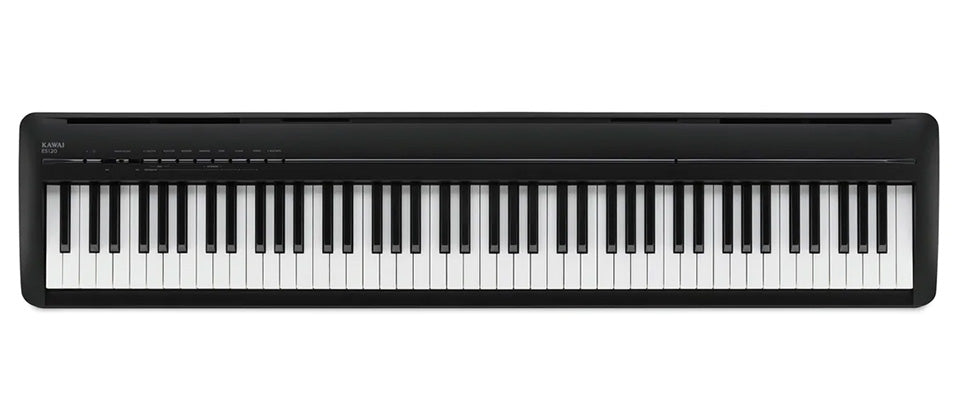
Upright Piano Voice
New for the ES120 is the introduction of an upright piano voice. This is a highly authentic upright piano sound and reminds us of the type of piano that many of us learned on back in the day. You'll hear that the bottom registers are slightly detuned, and this is a lovely voice to play blues or ragtime-style music. You may also like to try the bright tone of the EX Modern Concert Grand. This sound has a real cutting edge to the tone and, as the name suggests, is best suited to rock & pop style performances.
Hammer Action Keyboard
Built around an improved version of Kawai's compact Responsive Hammer Action keyboard, the ES-120 digital piano provides a highly satisfying piano experience. The total 20 watts amplification output provides a full-bodied sound that belies the small form-factor cabinet design, whilst the choice of 25 different instrument voices makes the instrument versatile enough to cover many different musical tastes & styles.
Control Panel
The control panel of the ES120 is nicely laid out and very intuitive. As with most pianos in this price category, however, many hidden functions require combinations of multiple button and key presses to access them, but thankfully the ES120 can be controlled using the popular Kawai PianoRemote app for iOS or Android devices. This means you can control most of the piano's features using your tablet's or mobile phone's touchscreen, which makes getting into some of the more advanced functions so much easier.
Kawai ES120 Piano Review

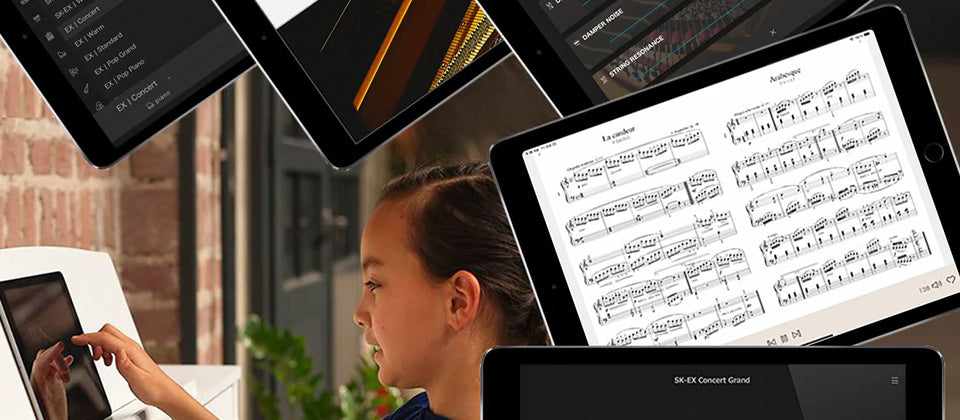
Bluetooth & Apps
The ES120 is also compatible with the PiaBookPlayer score viewer app, which is a musical score display app for Kawai digital pianos.
PiaBookPlayer is available for most iOS and Android devices, and it allows you to view the notated scores of the many lesson songs and practice pieces that are built into the ES120.
PiaBookPlayer makes full use of the wireless Bluetooth MIDI feature and allows players to enjoy listening to classical pieces whilst viewing their musical scores. This app also allows pages of the notated score to be turned using the instrument’s soft or sostenuto pedals if you've got the optional GFP3 triple pedal attached.
Included in our ES120 video review is a demo of some of the other voices available to show how this piano can be used to play many different musical styles.
Kawai ES120 Piano Review

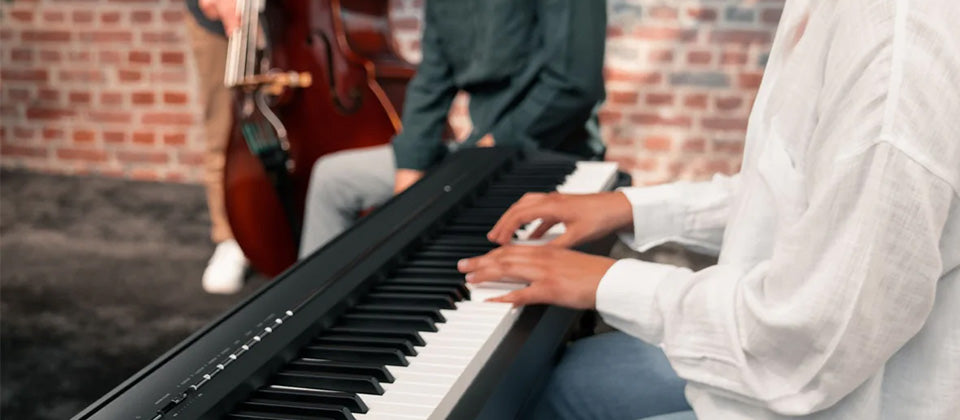
Electric Piano Voices
There are four different EP voices in the ES120. One of our favourites is the sound of the Vintage Reed Electric Piano.
The Classic Whitney Houston Sound!
Back in the 1980's Yamaha developed its first digital synthesiser, and it was called the DX7. This model sold over 200,000 units and is still, to this day, one of the best-selling synthesisers of all time.
The DX7 was capable of producing sounds that had never been heard before from an electronic keyboard instrument, including one of the most iconic tones from the eighties and early nineties, which was the DX7 Electric Piano 1 voice. You'll recognise this sound from ballad-style songs, including many sung by Whitney Houston and Natalie Cole.
Kawai ES120 Piano Review

Shop the ES120 Range
Kawai ES120 Piano Review

Split Keyboard Mode
The ES120 keyboard can be split to play two different sounds at the same time. A really good example of this feature is to assign the sound of the acoustic bass with a ride cymbal to the left hand whilst playing the piano on the right.
Layer Keyboard Mode
It is also possible to layer two voices together, which creates some really nice sound textures. One of our favourites is to layer the sound of the concert grand piano with the orchestral strings. By pressing the piano and 'other' sound buttons simultaneously, it mixes the two sounds together, so you hear the sound of two voices on every key of the instrument.
Registration Memories
Registration memories provide a way of storing your favourite settings on the piano. For example, you may like to always play a particular piece using a piano voice mixed with the choir. Once you have set up the sound combination and adjusted the levels of each voice, you can store this as a 'registration; for instant recall. It saves you time and is a convenient way to set up the piano quickly - and is particularly useful during live performances.
Metronome & Drum Rhythms
Practice with a metronome is very important to improve your timing. The ES120 has a built-in metronome that offers all the popular time signatures and 100 drum rhythms to make practice even more fun!
Internal Song Recorder
When practising, the ability to record and listen to your performance is very useful. The ES120 allows up to 3 songs to be recorded into its internal memory and the total memory capacity is 15,000 notes. You can use the recorder to either record a complete performance or just record one hand part of a piece and practice the other part whilst playing back the recording.
Other Features
The onboard total 20w amplifier drives two 12cm speakers for a good quality sound output whilst keeping the actual size and weight of the instrument to a minimum in order to maintain portability.
Kawai ES120 Piano Review

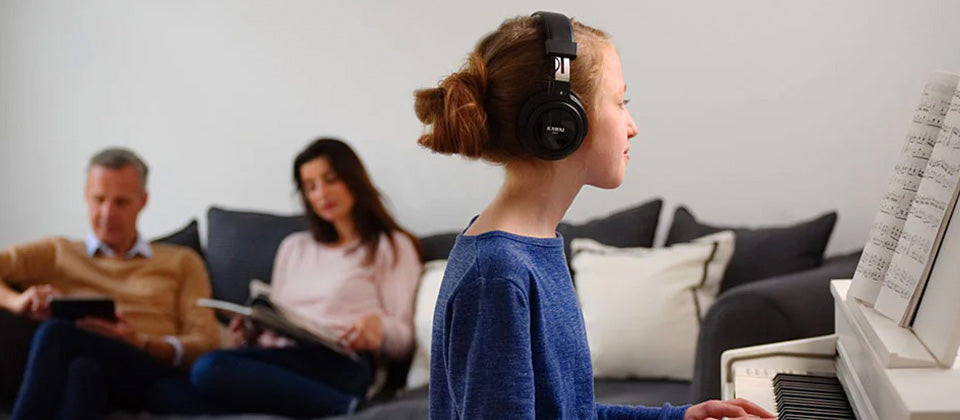
Headphones For Silent Practice
Many people choose digital pianos for the convenience of being able to practice silently using headphones.
It is possible to connect two sets of headphones to the Kawai ES120 for practising without disturbing others in the household. The headphone output is enhanced with Kawai's Spatial Headphone Sound (SHS) to make playing with headphones just as enjoyable as through the instrument's own speaker system.
We recommend Kawai's own SH9 headphones as a good match for the ES120, but it is compatible with most brands of headphones and earphones. Just remember that no digital pianos make use of wireless Bluetooth headphones because there is a latency or delay between pressing the keys and you hearing the sound through the headphones, which could be a little disconcerting. Maybe one day, Bluetooth will get a little faster so it can be used for musical instruments, but for now, piano players need to use wired headphones for silent practice.
Kawai ES120 Piano Review

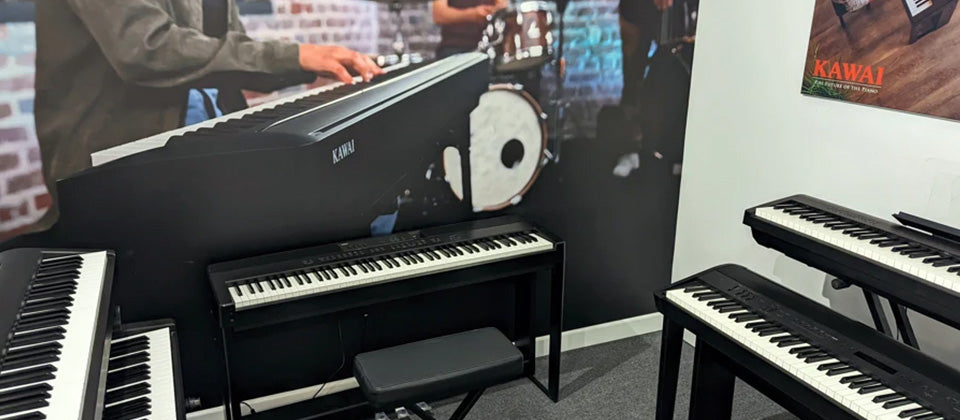
See the ES120 in our piano stores.
The ES120 is usually available for you to try in our three piano showrooms, where you can compare this model with other instruments from different manufacturers. Our showrooms are located in Reigate in Surrey, Milton Keynes, and on the South Coast in Eastbourne.
If you need help choosing the right digital piano for your particular needs, give our friendly, knowledgeable staff a call or email us, and we'll be happy to share some helpful information with you.
Kawai ES120 Piano Review

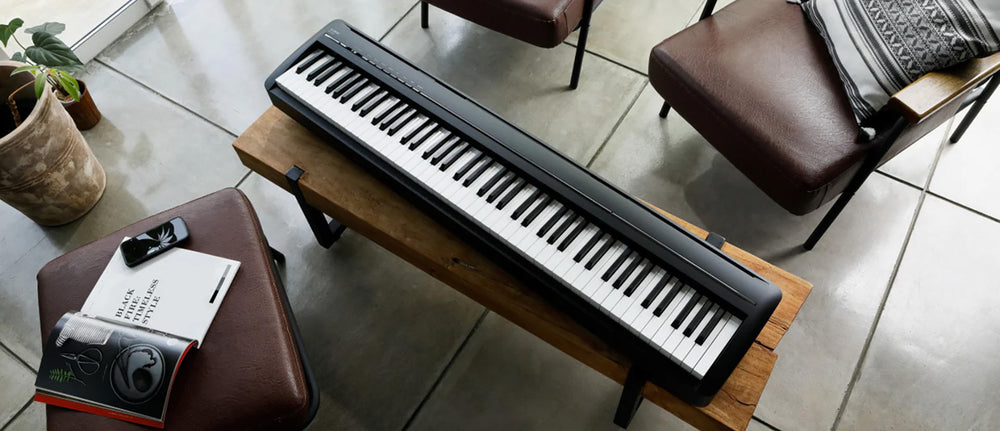
Conclusion
This new piano from Kawai represents a significant upgrade on the older ES110 model in almost every area.
The styling is better, it has Bluetooth MIDI & Audio capability with Support for Kawai’s latest PianoRemote and PiaBookPlayer apps, the piano sound has been improved, and the speakers are more powerful. All these features come at a price, with the new model being about £100 more expensive than its predecessor.
Like Yamaha, Roland and Casio models of comparable prices, Kawai appears to have also saved a bit of money by only including a plastic sustain footswitch in the box. We would always recommend upgrading the pedal to a more substantial metal pedal which you can purchase for about £25 upwards.
Kawai ES120 Piano Review

Watch Our Kawai ES120 Buyers' Guide
Kawai ES120 Piano Review

















